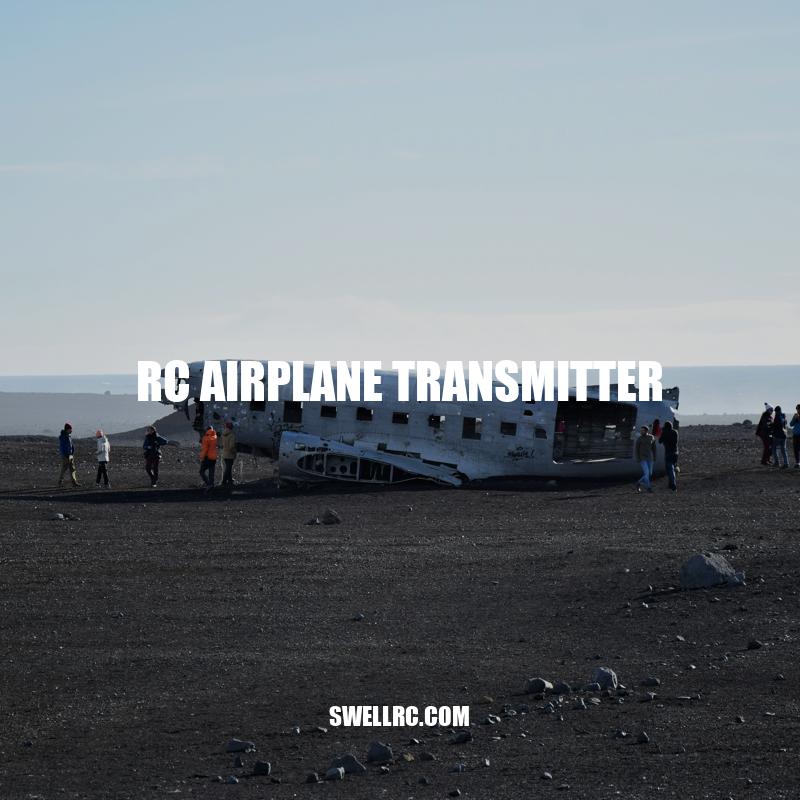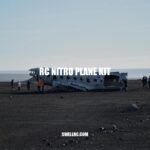Mastering RC Airplane Transmitters: Selecting and Using the Right One
Radio-controlled (RC) airplanes have become increasingly popular among hobbyists and aviation enthusiasts alike. To enjoy the thrill of flying an RC airplane, a reliable transmitter is required. An RC airplane transmitter is a handheld device that sends radio signals to the aircraft’s receiver to control flight performance, including steering, altitude, and speed. It consists of a variety of features, from the number of channels to the frequency response range, ergonomics and more. With a wide range of options in the market, selecting the right RC airplane transmitter for personal needs may seem like a daunting task. It requires an understanding of the different types of transmitters, features, and other components that come into play. In this article, we will discuss everything one needs to know about RC airplane transmitters, highlighting the key things to consider when choosing one, how to use it and important safety tips.
Types of RC Airplane Transmitters
RC airplane transmitters come in different types intended for a range of skill levels and budgets. Here are some of the most common types of RC airplane transmitters:
- Entry-level transmitters: These transmitters are designed for beginners and entry-level airplane operations. They usually have four or fewer channels and are cheaper than more advanced options. They may lack some features that experienced fliers may find important, such as programmable mixes and custom displays. Good options for entry-level transmitters include the Flysky FS-GT5, the Spektrum DX6e and the Futaba 6J.
- Mid-range transmitters: These types of transmitters are for moderate to experienced fliers. They have additional features such as telemetry, voice alerts, and more programming options. They have up to six to eight channels, and they tend to cost more than entry-level transmitters. Good options for mid-range transmitters include the FrSky Taranis X9D+ and Spektrum DX8.
- High-end transmitters: These types of transmitters are for advanced fliers who demand the best in terms of features and performance. They come with advanced telemetry systems, large color touch screens, and programmable mixes. They have up to 16 channels and can control complex aircraft setups. High-end options include the Futaba 16SZ, Jeti DS-24 and Spektrum DX18.
When choosing an RC airplane transmitter, it is important to consider the skill level of the operator, the budget, and future plans for one’s RC airplane hobby. Additionally, one can also consult reviews, user guides, and product specifications from websites like Amazon, Hobby King and RCGroups to get some insights before making a purchase.
What are the different types of RC transmitters?
RC transmitters come in different types, each with unique features and capabilities. Some of the most common types include:
| Type | Description |
|---|---|
| Mode 1 | Throttle and yaw controls are on the left stick, while pitch and roll are on the right stick. |
| Mode 2 | Pitch and roll are on the left stick, while throttle and yaw controls are on the right stick. This is the most popular type of transmitter. |
| Mode 3 | Similar to Mode 1, but with the right and left sticks reversed. |
| Mode 4 | Similar to Mode 2, but with the right and left sticks reversed. |
| Gamepad-style | Designed like a video game controller, offering intuitive controls for gamers. |
It’s important to choose a transmitter that is compatible with your specific RC model and matches your personal preferences and flying style. Websites such as Hobbyking, Tower Hobbies, and Amazon offer a variety of RC transmitters for purchase.
Features of RC Airplane Transmitters
RC airplane transmitters come with different features that can impact the flying experience of an operator. Here are some of the features to look for in an RC airplane transmitter:
- Number of Channels: The number of channels determines how many functions can be controlled with the transmitter. Entry-level transmitters generally have fewer channels, while high-end models can support up to 16 channels.
- Frequency Range: The frequency range affects the performance of the transmitter’s signal. The transmitter should be compatible with the receiver’s frequency range to avoid interference and poor signal quality.
- Transmitter Range: The transmitter range is the distance between the operator and the aircraft before the signal is lost. The range depends on the type of transmitter and the environment where the aircraft is flown.
- Battery Life: The battery life determines how long the transmitter can operate on a single charge without giving up on its signal quality and control performances.
- Telemetry: Telemetry data can be useful for monitoring the aircraft’s status, such as battery life, altitude, and speed. The feature is available in mid-range and high-end transmitters.
One of the most important features to consider is the number of channels. This feature determines how many functions can be controlled with the transmitter. The channels can be used to control different surfaces of the aircraft, such as ailerons, rudders, and throttle. A basic transmitter may have only two channels to control the rudder and throttle, while a high-end unit can have up to 16 channels to control complex setups. The frequency range is also important to consider since a transmitter should be compatible with the receiver’s frequency range to avoid signal interference.
Here is a table summarizing some of the features of the popular RC airplane transmitters mentioned in the previous paragraphs:
| Transmitter | Number of Channels | Frequency Range | Transmitter Range | Battery Life |
|---|---|---|---|---|
| Flysky FS-GT5 | 6 | 2.4055-2.475GHz | 500m | 8 hours |
| FrSky Taranis X9D+ | 16 | 2.4GHz | 1.5km | unknown |
| Futaba 16SZ | 16 | 2.4GHz | unknown | unknown |
When choosing an RC airplane transmitter, consider what features are important, and what specifications to look for. It can also be useful to read reviews and check user guides to get some insights into the performance and handling of the RC airplane transmitter you are considering, on websites like Amazon, Hobby King, and RCGroups.
What does a plane transmitter do?
A plane transmitter is a radio device on an aircraft that broadcasts radio signals to communicate with air traffic controllers or other aircraft. It allows pilots to receive instructions and give updates on their flight status. The transmitter sends out information such as altitude, speed, and direction of the plane. These signals are received by air traffic control stations, which can then provide information on weather conditions, airspace restrictions, and other relevant details.
There are several types of plane transmitters, including Very High Frequency (VHF) and High Frequency (HF) transmitters. VHF transmitters are used for short-range communications, while HF transmitters are used for longer distances and can communicate with aircraft over oceans and other remote areas.
For more information on plane transmitters, you can visit aviation-related websites such as AOPA (Aircraft Owners and Pilots Association) or the FAA (Federal Aviation Administration). There are also many aviation equipment suppliers such as Sporty’s Pilot Shop and Aircraft Spruce that offer a variety of airplane transmitters and related products.
Radio System Components
An RC airplane transmitter is composed of several components that work together to control the aircraft. Here are the most common components of an RC airplane transmitter:
- Transmitter Module: The transmitter module is responsible for sending the signals to the receiver that controls the servos. It is connected to the antenna and powered by a battery.
- Antenna: The antenna transmits the signal from the transmitter to the receiver. There are two types of antenna, omni-directional and directional antennas, which cater to specific flying conditions.
- Receiver: The receiver is installed on the aircraft, and it receives the signals from the transmitter. It then converts the signals into servo movements.
- Servos: Servos are connected to the receiver and control the flight surfaces of the aircraft. They respond to commands from the transmitter, such as turning the rudder or moving the flap.
Each component should be well-maintained and in good working condition to ensure the safe and efficient operation of the aircraft. Failure of any of the components can cause the aircraft to lose its control and potentially result in a catastrophe.
Choosing the right components for an RC airplane transmitter can also affect the performance of the aircraft. For example, high-quality servos with a high torque rating are recommended for larger aircraft or for aggressive flying styles. On the other hand, lightweight servos may be used for slow flyers or smaller aircraft. The directional antenna has added advantages over the omni-directional one that is prone to more interference.
Good maintenance of the components is essential in ensuring that the RC airplane’s radio system is operating effectively. One of the best ways to learn how to maintain an RC airplane transmitter and its components is by visiting RC hobby websites such as RCGroups or RC Universe. They have forums where experienced RC hobbyists share their tips and tricks, knowledge, and recommendations on the ideal components needed for RC airplane transmitters.
What are the components of RC transmitter?
A typical RC transmitter has several key components, including a control stick, an on/off switch, an antenna, batteries, and various buttons for controlling settings. Additionally, some transmitters may have LCD screens for displaying information such as battery level and signal strength. For a more detailed breakdown, check out websites such as rcadvisor.com or read product manuals for specific models.
When selecting an RC airplane transmitter, several factors should be considered. Here are some of the essential factors to think about:
- Experience Level: The level of experience plays a crucial role in selecting a transmitter. Beginners may prefer entry-level transmitters while advanced users may want to invest in a high-end model with more features.
- Type of Aircraft: Different types of aircraft require different types of transmitters. Smaller aircraft may only need 2 to 3 channel transmitters, while larger models may require up to 16 channels.
- Budget: The price range of RC airplane transmitters varies significantly. Entry-level transmitters may be purchased for less than $100, while high-end models can cost over $1000. It is essential to select a transmitter that is within your budget so that you don’t overspend on just one component of the RC airplane hobby.
- Brand: The brand of the transmitter can also affect the quality and performance of the product. Popular brands such as Spektrum, Futaba, and FrSky offer high-quality transmitters with numerous features and customizable options.
It is recommended to do some research before selecting an RC airplane transmitter. Reviews and product comparisons can provide valuable insight into the features and capabilities of different transmitters. Many websites, such as RC enthusiast magazines like Model Airplane News, host reviews on different RC airplane transmitters and related products.
For those who want to purchase a transmitter online, there are several trusted online stores such as Horizon Hobby and Tower Hobbies. These online retailers offer a wide range of transmitters, including the latest models and high-end options. With dedicated customer support and fast shipping, they are an excellent choice to provide excellent customer service and after-sales care when the need arises.
How to choose RC plane electronics?
When choosing RC plane electronics, there are a few factors to consider. Here are some tips to help you make an informed decision:
- Size and weight of the plane: Choose components that are appropriate for the size and weight of your plane.
- Type of control system: Consider whether you want a traditional radio-controlled system or if you prefer to use a computerized system.
- Battery life: Choose a battery with a long lifespan to keep your plane in the air longer.
- Motor specification: Select a motor that suits your plane’s weight and size, as well as the flying conditions it will face.
Websites such as HobbyKing, Amazon and Tower Hobbies offer a wide range of RC plane electronics to choose from. It’s important to read product descriptions and reviews to ensure you are purchasing the right components for your needs. Some popular products include:
| Component | Recommended Product |
|---|---|
| Radio Control System | FlySky FS-i6X 10CH 2.4GHz AFHDS 2A RC Transmitter |
| Battery | Zeee 11.1V 50C 5200mAh LiPo Battery Pack |
| Motor | XYZHOBBY 2212 1400KV Brushless Motor |
| ESC | HOBBYWING EZRUN 60A-SL ESC |
How to Use an RC Airplane Transmitter
Using an RC airplane transmitter may seem daunting at first, but it is relatively simple with practice. Here are some tips on how to use an RC airplane transmitter:
- Pre-Flight Checks: Before turning on the transmitter and flying the RC airplane, ensure that the aircraft is in good condition and everything is connected correctly. Check the battery levels of both the transmitter and the aircraft, and make sure that the control surfaces move in the right direction.
- Calibration: Before flying, calibrate the transmitter and receiver to ensure that everything is working correctly. Follow the manufacturer’s instructions to complete this process.
- Takeoff: Start the aircraft and ensure that it is pointed in the right direction. Begin moving the controls slowly to increase the throttle, and as the airplane takes off, adjust the throttle to maintain altitude.
- Flying: Once the airplane is in the air, use the different controls to steer, bank, and climb/descend the aircraft. It’s essential to maintain a steady speed and altitude to avoid crashing.
- Landing: When landing, reduce the throttle gradually and guide the aircraft toward the ground. Pull back on the throttle to reduce speed, and level out the aircraft to slow its descent. Once on the ground, reduce the throttle completely and turn off the transmitter and airplane.
It’s essential to practice using an RC airplane transmitter to gain confidence and improve skills. Several online resources provide valuable tips and tricks, including RC enthusiast forums, YouTube tutorials, and instructional websites such as RC Groups and Flite Test. These resources provide useful information on everything from basic controls to advanced maneuvers.
There are also simulator programs and apps available that simulate the experience of flying an RC airplane. These software options provide a safe and practical way to practice using the transmitter and flying the aircraft. Programs such as RealFlight and Phoenix RC offer a realistic experience that can help improve RC airplane piloting skills.
How do you hold a RC plane transmitter?
To hold a remote control (RC) plane transmitter, grip it with both hands and keep a straight posture. Use your index fingers and thumbs to operate the sticks and buttons respectively. Practice holding the transmitter in a comfortable way before flying the plane.
Here are some tips for holding an RC plane transmitter:
- Keep the transmitter at a comfortable distance from your body to avoid any interference with the antennas.
- Use a neck strap to secure the transmitter in case you need to release your hands for any reason.
- Make sure the sticks and buttons are within reach of your fingers, but not too close that you’ll accidentally activate them.
To learn more about RC planes and flying them, there are many websites and products available. Some popular websites include:
- RC Groups – an online forum for RC enthusiasts to discuss and share information.
- HobbyKing – a website that sells RC planes, parts, and accessories.
There are also many RC flight simulators available that allow you to practice flying without risking damage to your actual plane. These simulators often come with a transmitter controller that closely resembles a real one, helping you get used to holding and using it.
Conclusion
RC airplane transmitters are a vital component of any RC airplane setup, allowing pilots to control their aircraft from the ground. It’s essential to choose the right transmitter, based on the aircraft’s type, experience level, and budget. New technologies such as FlySky FS-i6X Transmitter and Spectrum DX6e Transmitter have made it more accessible and affordable to fly RC airplanes compared to older models. With practice and patience, RC pilots can master the skills needed to fly an RC airplane and enjoy the rewards of this exciting hobby.
Moreover, RC airplane enthusiasts should also explore and follow other hobbyists and experts in the field. Joining online forums, reading relevant blogs, and following social media groups allow people to stay up to date on newly released transmitters and technologies, repair and maintenance tips, and other useful information. By keeping up with the latest trends and knowledge, individuals can become an integral part of the online RC airplane community, exchange ideas and information, and meet new friends who share their passion for RC aviation.



